
views
Using Protective Accessories

Install a screen protector to make the screen more damage-resistant. First, purchase a screen protector that matches the model of phone you have. They cost as little as $5 USD despite how much they protect your phone. Peel off the protector’s adhesive backing, then lay it over your phone’s screen. When the protector gets scratched, you can peel it back off and replace it to keep your phone’s screen covered. Screen protectors tend to be somewhat delicate. They scratch easily, and many people don’t like having them, but it’s a better option than ending up with a damaged screen. There are different types of protectors, such as tougher tempered glass ones and inexpensive plastic ones. You can even get liquid screen protectors you spray onto your phone.

Shield your phone’s exterior with a sturdy full-body case. Choose a case that fits the model of phone you have. Cases are relatively inexpensive, and you can get good ones for $20 or less. Make sure your phone is secure inside the case so it can’t slide out when you least expect it to. Cases come in a variety of colors and patterns, so you can always find one that looks good on your phone. If you like showing off your phone’s natural finish, then find a transparent case. It won’t be completely unnoticeable, but the protection you get from it is worth the inconvenience. For maximum protection, pair a case with a screen protector.

Put a protective skin on your phone for a decoration that also resists scratches. Phone skins are similar to cases but are sleeker. If you find cases to be too bulky, a skin will preserve your phone’s original shape and appearance. To use a skin, peel off its backing, then stick it on your phone. As it gets scratched up, you can peel it off and replace it. Skins are not as protective as cases. They do a good job of guarding against scratches, but they don’t help much if you’re prone to dropping your phone. Skins can’t be used with cases, unfortunately. However, you can still install a screen protector for more insulation.

Get a case with a finger loop to better carry your phone. This kind of case has a ring on the back. When you slip the ring over your finger, you become less likely to drop the phone while you’re using it. It’s a very convenient way to keep your phone elevated above potentially damaging debris. It also provides your phone with a layer of padding like other cases do. Finger loop cases are great for anyone on the go. For example, if you’re exercising, you won’t have to put your phone down in a spot where it could potentially get damaged. Use your phone with caution. You can still bump it into things that will leave scratches. If you’re not used to having your phone stuck to your finger, you might forget that you have it on.

Purchase a belt clip or another alternative to carry your phone safely. Belt clips are a good option if you’re on the go a lot. Slide the clip onto your belt, then place your phone into it. You could also get holsters or pouches that offer more protection than basic clips. If you exercise, you could get an armband or a waist pack to hold your phone. There are many different options for carrying a phone safely, such as gadget bags or clothing with cushioned pockets. Your phone is at more of a risk for scratches when it is exposed or left in small, shallow, or dirty pockets. If you don’t want to use a clip, choose clothing and accessories that have extra pockets. For example, wear a shirt that has a front pocket and use it to store your phone.
Storing Your Phone

Put your phone away instead of leaving it out in the open. To avoid scratches, don’t set your phone down in any unsafe spots. If you have to leave it out, place it on a solid surface, like a countertop. Keep it distant from the surface’s edges. Also, make sure it’s away from debris, metal, or anything else that could harm it. For example, your phone could fall between the cushions if you set it on your couch. It might be exposed to debris or sharp edges if it’s in your kitchen. Scratches often happen when you least expect them. Keep in mind that proper storage also protects your phone from fall damage.

Carry your phone in a pocket you don’t use for anything else. Try dedicating a specific pocket to your phone. If you carry your phone in your pants pocket, for instance, set aside one of the pockets for your phone. Move everything else over to your other pocket. That way, your phone will come into contact with fewer things that could scratch it. If you carry your phone in a handbag or backpack, move it to a side pocket. You might be tempted to throw it into a main pocket for easy access, but it won’t be as safe there. Clean pockets are better. Remember that your phone can come into contact with debris left in pockets you frequently use, even if you don’t happen to have anything else in there If you use the pocket to carry something other than your phone, remember to turn it inside-out to shake out any debris. Also, wash it as needed.
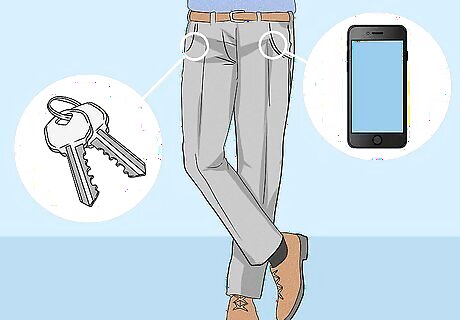
Store metal in a different pocket from your phone. One of the easiest ways to damage a phone is by throwing it into a pocket with your house keys. Coins are also a scratch hazard. Some other metal objects that could scratch your phone include pens, pencils, keychains, and knives. Even if you don’t have your phone in your pocket, be careful about where you put it. You might come home and toss everything onto a countertop, for instance, so your phone and keys could still come into contact with one another.
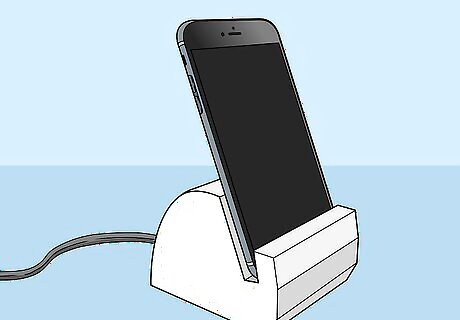
Use a desktop phone dock to charge your phone more safely. Place the dock in a spot where it won’t get knocked over. Then, place your phone on top of it. Some docks have a built-in charger you can take advantage of to keep cords away from your phone. Others are just for holding your phone but have a hole in the back you can route a charging cable through so it isn’t left exposed on the ground. Charging docks support your phone so you don’t even have to pick it up to use it. They keep it elevated above debris, metal, or anything else that could possibly leave scratches. Docks are good for hiding charging cables. By tucking the cable under a dock, you are less likely to step on it and pull your phone onto the floor.

Place your phone in a dashboard dock when you’re in the car. Vehicle phone docks come in a variety of styles. Generally, they stick to either your dashboard or windshield. When you place your phone in the dock, you can use it hands-free. It makes using a phone safer while driving, but it also keeps your phone away from harmful debris. For example, you might store your phone in a cup holder. You might also store food, drinks, or a number of other things there. Using a dock ensures your phone is far away from anything left in the cup holder.
Cleaning Dirt and Debris

Wipe your phone off with a microfiber cloth at least once a week. Take your phone out of its case, then clean off the screen. Wipe off the phone’s exterior afterward. When you’re done, clean the microfiber cloth with soap and water in a washing machine. If you do this regularly, you can eliminate dirt and other debris before it ever has a chance to scratch your phone. Make sure you use a cloth that won’t leave scratches, particularly when wiping down the screen. Paper towels, for instance, are too rough. While you’re wiping your phone clean, you can also disinfect it. Dampen the cloth in a little bit of isopropyl alcohol before using it. Your phone will come into contact with debris no matter what, so regular maintenance is necessary for preventing scratches. You won’t even be able to see debris most of the time, but it is still there.
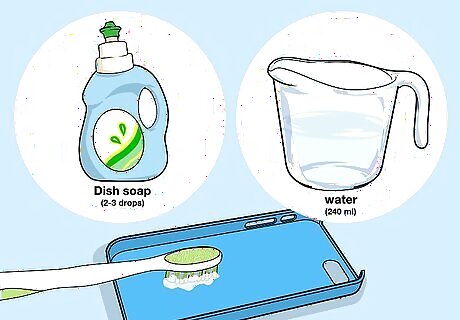
Scrub your phone case with soap and water at least once a month. While your phone is out of the case, mix together about 1 cup (240 mL) of warm water with 2 or 3 drops of dish soap. Use a mild dish soap without any strong scents or chemicals. Scrub the case clean using a toothbrush dipped into the soapy water, then rinse it off under clean water. Finally, dry it off with a microfiber cloth before putting it back on your phone. A phone case is great to have for protection, but it can trap debris on your phone. If you don’t take time to clean the case on occasion, you run the risk of grinding dirt into your phone’s finish, leaving some very unpleasant scratches.
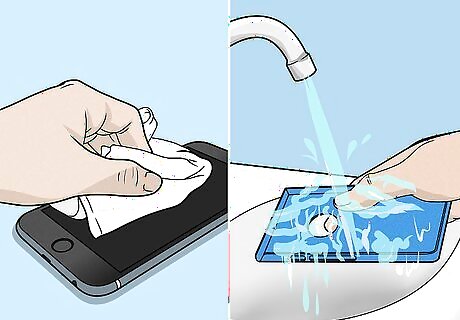
Clean your phone immediately after getting it dirty. If you take your phone somewhere special, such as to a beach, it’s at more of a risk of permanent damage. Sand gets everywhere, even if you never set your phone down. As soon as you get home, wipe your phone clean and wash its case. Do this every time your phone comes into contact with harmful debris. For instance, you might drop your phone when you’re at the beach or on a dirt path. If you take the time to clean your phone right away, its finish will stay scratch-free for longer. Sand is one of the biggest causes of scratches. Many times, you can’t even see the sand, so the only way to avoid scratches is with diligent cleaning. Remember to clean everything, including your pockets.
Removing Scratches
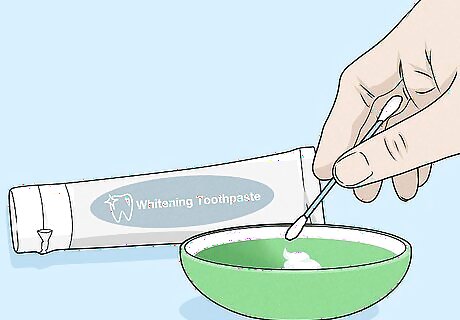
Select a whitening toothpaste to use on the scratch. Make sure you’re using an actual paste instead of a gel. Abrasive pastes, such as ones containing baking soda, work very well on scratches. Take your phone out of its case and set it beside the toothpaste on a stable surface. If you don’t have a toothpaste, you could also mix 3 parts baking soda with 1 part water to create your own paste.
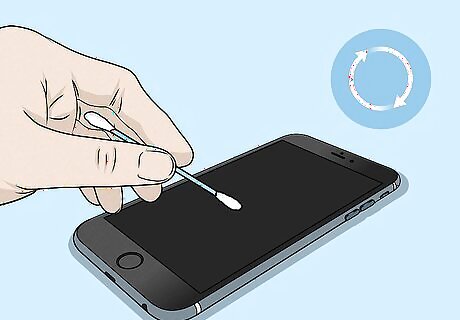
Dab a small drop of toothpaste onto a cotton swab. Pour some of the toothpaste into a small bowl first, then pick up a pea-sized amount with the swab. You could also use a clean microfiber cloth. Brush the excess back into the bowl before attempting to fix your phone. Remember that the paste is abrasive, so don’t use more of it than you need. It could leave more scratches if you’re not careful.

Rub the paste in a circle around the scratches on your phone. Press the paste into the middle of the scratch before buffing it out. Move gently in a circular motion. Keep moving until the scratch disappears. Even if the scratch is too deep to completely fix, you will notice it lessen as you scrub. If the scratch is too deep, you won’t be able to fix it with toothpaste. You could take your phone to a repair shop for a more permanent fix. They can replace the screen and casing in many cases.
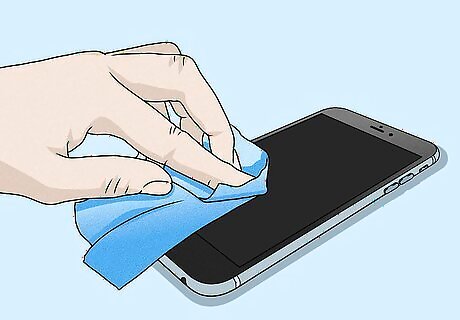
Wipe the toothpaste off with a damp cloth. Take a microfiber cloth and dip it into a little bit of warm water. Ring out the excess moisture before using it on your phone. Wipe from top to bottom until all of the toothpaste is gone. Use a dry part of the cloth to sop up the remaining moisture. After you finish fixing the scratches, you can polish the screen with a microfiber cloth. Clean off any dirt around the edges and inside the case to prevent more scratches from forming.




















Comments
0 comment